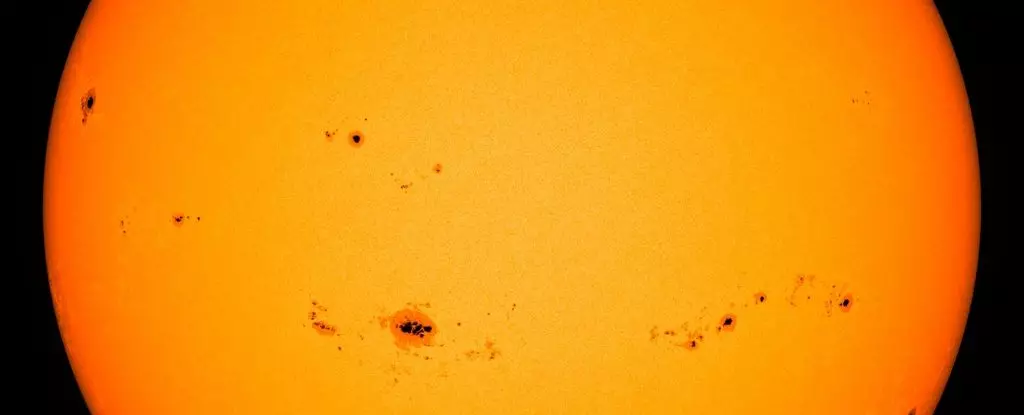NASA, the National Oceanic and Atmospheric Administration (NOAA), and the Solar Cycle Prediction Panel have recently made a significant announcement: we are officially entering solar maximum. This phase marks the pinnacle of an 11-year cycle, characterized by increased solar activity, including sunspots, solar flares, and coronal mass ejections. For those unfamiliar with solar phenomena, solar maximum represents a period of intense variability in the Sun’s behavior, prompting both excitement and concern among scientists and laypeople alike. The impending shifts in solar dynamics could influence everything from telecommunications to climate patterns on Earth.
Solar maximum signifies a period of heightened energy emanating from the Sun, as it gears up for the eventual transition towards solar minimum. During this time, solar activity can reach astonishing levels, with frequent bursts of energy and magnetic fluctuations. The current solar cycle has already begun to exhibit signs of increasing sunspot activity, which serves as a crucial indicator in monitoring solar behavior. Understanding the implications of these phenomena is vital for preparing for potential disruptions caused by solar activity.
The Enigmatic Nature of Solar Cycles
Despite extensive research, the scientific community still grapples with understanding the intricate mechanisms governing solar cycles. The Sun undergoes a cycle lasting approximately 11 years, although the duration and intensity of each cycle can vary considerably. This unpredictability complicates efforts to forecast solar activity accurately. Astrophysicists, including Michael Wheatland of the University of Sydney, acknowledge the challenges in comprehending the solar dynamo—the process that generates the magnetic fields visible as sunspots and other solar phenomena. The complexities involved in tracking the Sun’s internal mechanics further contribute to the difficulty in making reliable predictions regarding solar cycles.
Furthermore, the manifestations of these solar cycles are more than mere fluctuations in activity; they are indicators of the Sun’s underlying processes. The number of sunspots, in particular, serves as a key metric for understanding solar behavior. During solar maximum, sunspots appear abundantly on the solar surface, while solar minimum is marked by their scarcity. The interaction between these sunspots and the Sun’s magnetic field can lead to powerful explosions, releasing massive bursts of light and radiation—known as solar flares—and causing coronal mass ejections that can have cascading effects on Earth.
The effects of solar activity extend well beyond astronomical curiosity; they have tangible impacts on life on Earth. Solar flares and coronal mass ejections can generate geomagnetic storms, which pose risks to satellite operations, power grids, and other critical infrastructure. The magnetic field fluctuations induced by these solar phenomena can interfere with communication systems and disrupt navigation tools, leading to widespread systems failures.
However, it’s not just a story of risk and disruption. The interaction of solar particles with the Earth’s atmosphere results in breathtaking displays of natural beauty—auroras. This year has witnessed an abundance of auroral activity as a direct consequence of increased solar outbursts, captivating observers across the globe. The delicate dance between the Sun and Earth’s magnetic field reminds us of the intricate connection we share with our celestial neighbor.
While the current solar cycle has surpassed initial predictions for strength and activity, it does not represent an unprecedented awakening of the Sun. The most potent solar flare recorded to date in this cycle reached an intensity of X9.0, placing it among the strongest flares ever observed. Yet, despite this impressive figure, it remains crucial to recognize that several previous solar cycles have produced even more vigorous activity.
Interestingly, some scientists have offered more accurate predictions of solar behavior compared to official models. As researchers delve into the nuances of the current cycle, the findings may yield important lessons about our predictive capabilities regarding solar cycles. This ongoing research has the potential to inform our understanding of the Sun and enhance the reliability of solar activity models in the future.
Looking Ahead: Preparing for Solar Activity
As we brace ourselves for the forthcoming solar maximum, the scientific community stands poised to observe and analyze the cavalcade of solar phenomena that are sure to follow. The unpredictable yet fascinating behavior of our Sun holds great significance not just for research purposes but for society as a whole. Increased knowledge regarding the intricacies of solar cycles can empower us to better prepare for their associated challenges.
The onset of solar maximum serves as a compelling reminder of the dynamic nature of our star and its profound influence on existence on Earth. By leaning into this period of heightened solar activity, we may uncover more secrets of the Sun, fostering a deeper appreciation for the celestial phenomena that shape our world. The dance of solar dynamics continues, and our curiosity will guide us as we navigate its twists and turns.


Leave a Reply